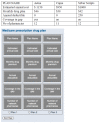Physician trainees' decision making and information processing: choice size and Medicare Part D
- PMID: 24116209
- PMCID: PMC3792159
- DOI: 10.1371/journal.pone.0077096
Physician trainees' decision making and information processing: choice size and Medicare Part D
Abstract
Many patients expect their doctor to help them choose a Medicare prescription drug plan. Whether the size of the choice set affects clinicians' decision processes and strategy selection, and the quality of their choice, as it does their older patients, is an important question with serious financial consequences. Seventy medical students and internal medicine residents completed a within-subject design using Mouselab, a computer program that allows the information-acquisition process to be examined. We examined highly numerate physician trainees' decision processes, strategy, and their ability to pick the cheapest drug plan-as price was deemed the most important factor in Medicare beneficiaries' plan choice-from either 3 or 9 drug plans. Before adjustment, participants were significantly more likely to identify the lowest cost plan when facing three versus nine choices (67.3% vs. 32.8%, p<0.01) and paid significantly less in excess premiums ($60.00 vs. $128.51, p<0.01). Compared to the three-plan condition, in the nine-plan condition participants spent significantly less time acquiring information on each attribute (p<0.05) and were more likely to employ decision strategies focusing on comparing alternate plans across a single attribute (search pattern, p<0.05). After adjusting for decision process and strategy, numeracy, and amount of medical training, the odds were 10.75 times higher that trainees would choose the lowest cost Medicare Part D drug plan when facing 3 versus 9 drug plans (p<0.05). Although employing more efficient search strategies in the complex choice environment, physician trainees experienced similar difficulty in choosing the lowest cost prescription drug plans as older patients do. Our results add further evidence that simplifications to the Medicare Part D decision environment are needed and suggest physicians' role in their patients' Part D choices may be most productive when assisting seniors with forecasting their expected medication needs and then referring them to the Medicare website or helpline.
Conflict of interest statement
Figures
Similar articles
-
Choice, numeracy, and physicians-in-training performance: the case of Medicare Part D.Health Psychol. 2010 Jul;29(4):454-9. doi: 10.1037/a0019881. Health Psychol. 2010. PMID: 20658834 Free PMC article.
-
One fish, two fish, red fish, blue fish: effects of price frames, brand names, and choice set size on Medicare Part D insurance plan decisions.Med Care Res Rev. 2012 Aug;69(4):460-73. doi: 10.1177/1077558711435365. Epub 2012 Feb 6. Med Care Res Rev. 2012. PMID: 22311955
-
Simplifying The Medicare Plan Finder Tool Could Help Older Adults Choose Lower-Cost Part D Plans.Health Aff (Millwood). 2018 Aug;37(8):1290-1297. doi: 10.1377/hlthaff.2018.0145. Health Aff (Millwood). 2018. PMID: 30080456 Free PMC article.
-
Government and private insurance medical programs as well as MDVIP, an update.J Long Term Eff Med Implants. 2004;14(3):243-50. doi: 10.1615/jlongtermeffmedimplants.v14.i3.80. J Long Term Eff Med Implants. 2004. PMID: 15301667 Review.
-
The private health insurance choices of medicare beneficiaries: how much does price matter?Med Care Res Rev. 2014 Dec;71(6):661-89. doi: 10.1177/1077558714556896. Epub 2014 Nov 4. Med Care Res Rev. 2014. PMID: 25371217 Review.
References
-
- Kaiser Family Foundation (2006) National Survey of Pharmacists and National Survey of Physicians. Available: http://www.kff.org/kaiserpolls/upload/7556.pdf. Accessed 2013, September 10
-
- Kaiser Family Foundation (2009) Medicare Part D Prescription Drug Plan Availability in 2009: Fact Sheet. Available: http://www.kff.org/medicare/upload/7426_05.pdf. Accessed 2013, September 10
-
- Kaiser Family Foundation (2013) Medicare Part D 2013 Data Spotlights. Available: http://www.kff.org/medicare/8375.cfm Accessed 2013, September 10.
Publication types
MeSH terms
LinkOut - more resources
Full Text Sources
Other Literature Sources
Medical


